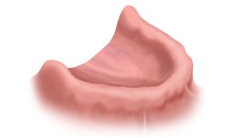 ALL TEETH MISSING
ALL TEETH MISSING
Benefits of a fixed bridge on implants
When all teeth are missing or in such condition that they need to be replaced, a fixed bridge anchored to dental implants is the optimal restorative solution.
Before dental implants, there were no fixed solutions available for people who lost all their teeth. Today, it is possible to replace a full jaw with dental implants and a fixed bridge that results in a stable and high esthetic solution.
- Lets you eat and function like having natural teeth
- A solid, stable restoration
- Preserves your facial appearance and prevents bone loss
Treatment:
The treatment procedure and number of visits is largely dependent on the specific conditions. But all in all, 8-10 visits should be enough to have a fixed bridge installed. Most patients report that they were much more comfortable following the procedure than they had anticipated.
>> View Treatment Procedure
COURSE OF TREATMENT
INSTALLING THE FIXED BRIDGE– STEP-BY-STEP
The course of treatment described here is one of several options available. Consult your dentist to find out what the best solution is for you, given your specific condition.
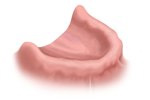 |
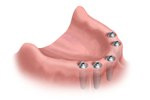 |
1: Before the procedure
The dentist determines what needs to be done and prepares both himself and the patient for the coming treatment procedure. |
2: Installing the implants
The first step is installing dental implants to replace the lost tooth roots. In this case, five implants are used. Temporary teeth can be attached that enable you to eat and function like normal while waiting for the final bridge to be installed. |
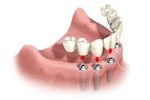 |
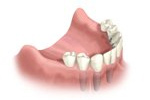 |
3: Attaching the bridge
The final bridge is securely installed on top of the implants. With a full jaw replacement like this, it normally takes 2-3 visits to have the bridge completely attached. |
4: End result
Your new teeth should be hard to tell from natural – both for you and others. People who have had traditional dentures before getting a fixed bridge often describe this as an overwhelming and very positive experience. |
ALTERNATIVES TO A FIXED BRIDGE
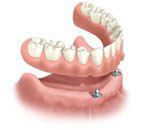 |
An alternative to a fixed bridge is a removable overdenture, which is anchored on implants. |
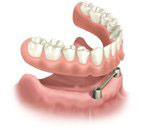 |
Removable, implant anchored overdenture
A removable full denture that is connected to either a ball or bar attachment, which in turn is anchored on two or more implants in the front part of the jaw.
The implants help keep the denture in place and provide better function and comfort. Although not as stable as a fixed bridge, cost is usually the reason why this solution is chosen. |
 |
Conventional full denture
A denture is placed on top of the gum to cover the lost teeth. This alternative has few real advantages. The disadvantages are many: discomfort in eating, affected speech, and sore gums from denture movement. Moreover, a full denture placed in the upper jaw severely reduces the sense of taste. |
Multiple Missing Teeth
 SEVERAL TEETH MISSING
SEVERAL TEETH MISSING
Benefits with fixed bridge on implants:
In this case, when replacing three teeth in the far back of the mouth, a fixed bridge anchored to dental implants is the only fixed alternative. Traditional dentures can't offer the same stability or function.
Having dental implants replacing your lost back teeth will give you new, unparalleled strength and stability that allows you to eat what you want. It will also preserve your jawbone and facial appearance.
- The only fixed alternative in this situation.
- A stable, secure solution that lets you eat what you want
- Preserves your facial appearance and prevents bone loss
Treatment:
After the initial examination, you can expect 4-5 additional visits until the final fixed bridge is attached. It is normal to experience some minor discomfort and swelling in the gum and soft tissue afterward the implants are placed. You should expect to be able to work the next day.
>> View Treatment Procedure
COURSE OF TREATMENT
INSTALLING THE FIXED BRIDGE– STEP-BY-STEP
The course of treatment described here is one of several options available. Consult your dentist to find out what the best solution is for you, given your specific condition.
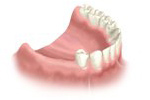 |
 |
1: Before the procedure
Three teeth at back end of the mouth are missing. The only fixed replacement alternative is installing an implant bridge. The bridge contains all teeth in one piece and is anchored on dental implants. |
2: Installing the implants
First, the implants are placed. This is normally done in a single appointment. |
 |
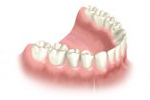 |
3: Attaching the bridge
The implants need to integrate with the jawbone before the final bridge is attached. This is normally done 3-4 months after the implant installation. The time will vary, depending on the teeth affected and the esthetic demands. |
4: End result
The new bridge will handle all the pressure that your strong, natural back teeth did. You will have a stable and secure solution that allows you to eat what you want. |
ALTERNATIVES TO FIXED BRIDGE
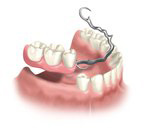 |
Removable partial denture
This alternative is often perceived as uncomfortable and a bit complicated to use. Food can get under the denture during chewing and speech can be affected. Chewing efficiency is far less compared to that of a bridge. This denture is made of acrylic and metal, which can also affect its look. However, it can be a cost effective alternative and has and natural teeth are spared. |
-
Back